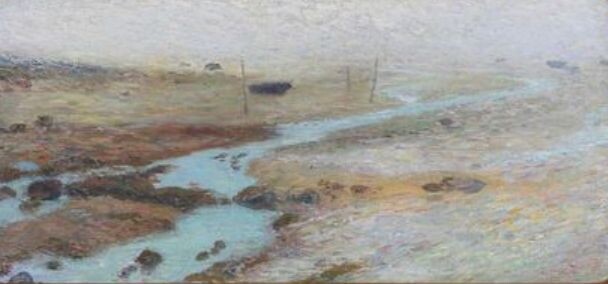Henri Martin (1860-1943) - Barques sur la grève à marée basse
\Artist: Henri Martin (1860-1943)
Technique: Oil on canvas\Signature: Hand signed\Dimensions: 84_120_4_cm
In its blond oak frame of the Maison Bellery-Desfontaines Certificate of authenticity of Mr Claude Cyrille Martin Painting in perfect preserved condition. Fast and secure shipping. As his first paintings and academies show it , this painter from Toulouse was first a faithful disciple of Jean-Paul Laurens (‘Paolo di Malatesta et Francesca da Rimini aux enfers,’ 1883, Carcassonne Museum) . In 1885, a stay in Italy introduced him to bright landscapes and Giotto's serene balance, but the artist also saw the paintings of Macchiaioli and Cremona and met Segantini, whose singular vermiculated and vibrant technique no doubt influenced him as much as Seurat's pointillism. Martin painted in small, broken, and parallel touches. In 1889 he realized his great historical evocation of the Feast of the Federation (Toulouse, Faculty of Letters) , then he turned to Symbolism, preferably painting allegorical canvases with poetic figures, celestial apparitions among hazy trees (“Sérénité, le bois sacré”, 1899, Musée d'Orsay) . His desire for mystical expression (“l’Inspiration,” 1895, Amiens Museum) is reflected in his beautiful symbolist portraits (“Portrait de Mme Sans,” 1895, Toulouse, Musée des Augustins) as well as in his murals with elegiac allegories ( 1893-1895, Paris, City Hall, South Entrance Lounge) . He chose Jean-Paul Laurens and Dampt to embody painting and sculpture. Henri Martin thus transformed "modernity" into general ideas: Jean Jaurès and Anatole France also became symbols in “les Bords de la Garonne “ (1906, Toulouse, Capitole) or “l’Étude” (1908, Paris, Sorbonne) . Henri Martin also took an interest in more popular contemporary life, painting peasants (“les Faucheurs”, 1903, Toulouse, Capitole; “les Vendanges” 1925-1928, and “le Labour”, 1929, Cahors, Lot Prefecture) , workers (“le Travail”, 1914, Paris, Palais de justice) or the Sunday walkers (“le Luxembourg”, 1935, Paris, the town hall of the 5th district) . His works were then increasingly marked by Fauvism, and his studies of faces with pure colours stripes had great strength (“Gustave Charpentier”, ca. 1931, Paris, Musée du Petit Palais) . On the other hand, this artist was a landscaper very sensitive to the colours and vibrations of his Languedoc land. He left many evocations of lost villages, old steeples and crumbling bridges, especially views of the large village where he spent the rest of his life, of his house and his garden (“le Village de Labastide-du-Vert”, 1903-1909, Museum of Lyon) . #exclusiveartweek
View it on
Estimate
Time, Location
Auction House
\Artist: Henri Martin (1860-1943)
Technique: Oil on canvas\Signature: Hand signed\Dimensions: 84_120_4_cm
In its blond oak frame of the Maison Bellery-Desfontaines Certificate of authenticity of Mr Claude Cyrille Martin Painting in perfect preserved condition. Fast and secure shipping. As his first paintings and academies show it , this painter from Toulouse was first a faithful disciple of Jean-Paul Laurens (‘Paolo di Malatesta et Francesca da Rimini aux enfers,’ 1883, Carcassonne Museum) . In 1885, a stay in Italy introduced him to bright landscapes and Giotto's serene balance, but the artist also saw the paintings of Macchiaioli and Cremona and met Segantini, whose singular vermiculated and vibrant technique no doubt influenced him as much as Seurat's pointillism. Martin painted in small, broken, and parallel touches. In 1889 he realized his great historical evocation of the Feast of the Federation (Toulouse, Faculty of Letters) , then he turned to Symbolism, preferably painting allegorical canvases with poetic figures, celestial apparitions among hazy trees (“Sérénité, le bois sacré”, 1899, Musée d'Orsay) . His desire for mystical expression (“l’Inspiration,” 1895, Amiens Museum) is reflected in his beautiful symbolist portraits (“Portrait de Mme Sans,” 1895, Toulouse, Musée des Augustins) as well as in his murals with elegiac allegories ( 1893-1895, Paris, City Hall, South Entrance Lounge) . He chose Jean-Paul Laurens and Dampt to embody painting and sculpture. Henri Martin thus transformed "modernity" into general ideas: Jean Jaurès and Anatole France also became symbols in “les Bords de la Garonne “ (1906, Toulouse, Capitole) or “l’Étude” (1908, Paris, Sorbonne) . Henri Martin also took an interest in more popular contemporary life, painting peasants (“les Faucheurs”, 1903, Toulouse, Capitole; “les Vendanges” 1925-1928, and “le Labour”, 1929, Cahors, Lot Prefecture) , workers (“le Travail”, 1914, Paris, Palais de justice) or the Sunday walkers (“le Luxembourg”, 1935, Paris, the town hall of the 5th district) . His works were then increasingly marked by Fauvism, and his studies of faces with pure colours stripes had great strength (“Gustave Charpentier”, ca. 1931, Paris, Musée du Petit Palais) . On the other hand, this artist was a landscaper very sensitive to the colours and vibrations of his Languedoc land. He left many evocations of lost villages, old steeples and crumbling bridges, especially views of the large village where he spent the rest of his life, of his house and his garden (“le Village de Labastide-du-Vert”, 1903-1909, Museum of Lyon) . #exclusiveartweek



